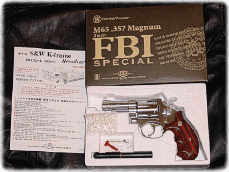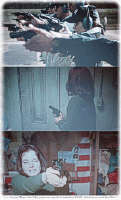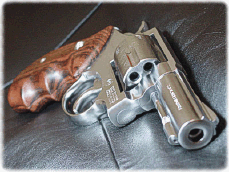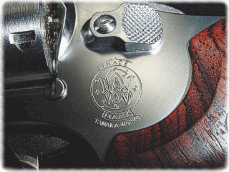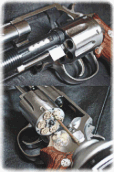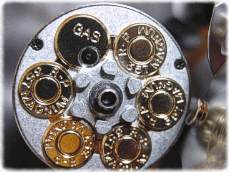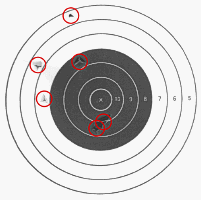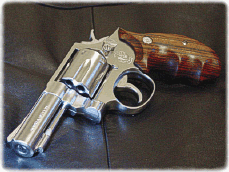Coming from a family of combat magnum K-frame revolvers, the M13/65 (along with their siblings the blued M19 and stainless M66) were favorites of law enforcement before the invasion of “wondernines.” In the ’80s the FBI adopted the 3-inch M13 as the standard issue sidearm for their field agents (they later switched to semi-autos). It’s unknown to me if the FBI issued the M65 along with the blued counterpart, but I doubt that they did. There are three models: two M13 versions in matte black and Midnight Blue and a silver M65. The M13 comes with ABS imitation wood target grips with a metal grip extension (just like the real FBI model) while the M65 is finished off with a beautiful pair of wood slabs with finger grooves and S&W medallions. The packaging is a departure from the usual colorfully designed box with the gun elegantly posed on the cover. Instead, the box is plain brown with beige lettering and some sort of official-looking, FBI-stamped graphic at one side. The graphic is of the FBI seal with some legal phrase printed over it. Tanaka’s “FBI” seal reads “Justice Department” and “Federal Bureau of Intelligence.” This, of course, is bogus. The actual seal says “Department of Justice” “Federal Bureau of Investigation.” Tanaka knows better than to mess with the feds! Along with the gun the package includes the manual, bag of BBs, loading tool, gas nozzle and barrel plug. Picking up the gun the one thing that strikes me are those gorgeous dark wood grips that really complement the “stainless” finish. The orange-brown with dark grains give a pleasing contrast to the semi-gloss silver. The grips have finger grooves with speedloader cutout on the left panel and are topped off with a silver S&W medallion on each side. They’re actually very nicely made, though not as refined as ones made by Hogue. They most certainly outshine the plastic grips on the M13. However, I find that the finger grooves are spread apart pretty wide and it’s not easy for me to find a comfortable grasp. The 3-inch barrel, low-profile sights, round butt and sans ejector shroud make the gun look compact even on the medium K-frame. The overall built of the gun is superb, typical of Tanaka’s craftsmanship. The ABS silver has a slight gloss and does give the illusion of being stainless. The contours are smooth and even and there’re no signs of any seams, not even inside the trigger guard. The bull barrel is thick, bigger than that of the M19 and in fact it’s about one millimeter wider in diameter than that of my M29. Unlike other S&W models such as the M19 or M29, the M13/65 (and M10) have no ejector shrouds, making them more compact. Weighing in at 533g, Tanaka’s replica is about 400g lighter than the genuine model. Even with a short 3-inch barrel the gun has good balance and is built rock solid. Metal parts include the hammer, trigger, cylinder, yoke and extractor rod, cylinder release, part of the frame and some internals. The trademarks are all there with Tanaka’s own branding blended in with S&W’s. The trigger action in both single and double proves to be very smooth and has a consistent travel. The hammer is checkered for easy cocking and the trigger is the smooth combat type. The sound of the hammer slamming down yields a nice metallic “clack.” The fixed sights are rudimentary, with a serrated blade being the front and a groove cut into the top of the frame serving as the rear. They’re designed to be low profile for simplicity and to allow for a rapid snag-free draw. Aiming didn’t pose any problems as the wide front blade fits snuggly into the rear notch. There’s no manual safety on the K-frame models. Unlike the M29 series, the cylinder release doesn’t double as a safety lever (the lever cannot be pushed rearward). I’ve sold my M60 awhile back so I don’t remember if the J-frame models have a manual safety. Opening the cylinder reveals the familiar sight present in other Tanaka revolvers. Six dummy cartridge casings are fixed onto the face of the cylinder. Five of the casings have “R-P 357 MAGNUM” engraved on them while the last one says “GAS” and has the injection valve. In the center is the usual gas release valve. Like other Tanaka models the extractor rod is non-functional as there is nothing to extract. The front is where the exit valve is located and is also where the BBs are loaded. An adjustable hop-up and a barrel seal are two new features that I’ve noticed in the S&W K-frame models. Unlike the M29 and the J-frame snub-nosed series, the M13/65 (and other K-frames) have an adjustable hop-up. The hop screw is located right above the barrel (like the Super Redhawk) and can be adjusted using a small hex wrench (not included, so you have to supply your own). At the entrance of the barrel is a cone-shaped, spring-loaded plastic cylindrical seal that retracts when the cylinder is closed in order to ensure a tighter seal between the cylinder and the barrel. This is a new design that I haven’t seen in previous Tanaka models that I’ve had. I’ve owned the Super Redhawk, M29, M60 J-frame and Colt Python series and this appears to be a new design that Tanaka has implemented. I haven’t seen other Colt models so I’m not sure if adjustable hop or the new seal are present in them. According to the manual the cylinder can hold 11 shots, but I was able to cram up to 12. Loading the BBs and gas is the same as with other Tanaka double action revolvers. The loading tool is used to push a partial amount of BBs (in this case six) into the magazine inside the cylinder. Then five BBs can be hand filled into the remaining five slot holes. Injecting the gas requires the use of the extended gas nozzle, as the standard gas can nozzles are too short. When I initially ran this gun through the chrono I was surprised at how low the power was. My 4-inch Colt Python produced 265 FPS average, and I had expected the K-frames to be lower. But I didn’t think it would be this low! So I removed the grips and adjusted the mainspring tension. The screw was pretty close to maximum already and I could turn only half way (180º clockwise) before it tightened. However, doing so prevented the grips from being installed as the mainspring had shifted slightly back, just enough to prevent the grip screw from passing through. The furthest I could turn was 90º, which did not make any improvements at all. The first 70 shots were all under 200 FPS. The average was 160, with a high of 199 and a low of 57 (that’s right, 57). After that the numbers started to climb, but not enough to satisfy me. From shots 71 to 134 the average was 207 FPS, with a high of 234 and a low of 82. I was able to get about 260 shots with one charge. Overall velocity average was approximately 184 FPS. Note that after the 134 th shot I grew tired of sitting in front of the chrono and decided to use the remaining shots for the accuracy part. Sound of the gun firing consisted of a “piff” and wasn’t loud at all, not nearly as loud as a full-sized GBB and nowhere as loud as Tanaka’s large-frame revolvers. As with Tanaka’s other revolvers that I’ve owned, the accuracy of the M65 was nowhere near being impressive. Firing at a steady double action mode the best 6-shot grouping I could achieve was 3.25 inches at a mere 10 feet away. Average groupings were 4.5+ inches. I believe the velocity deviation (100+ FPS at times) contributed to the inconsistencies. During target shooting I encountered several “misfires,” meaning the BB failed to fire and was still stuck in the cylinder slot hole. I’m guessing either the gas was too weak or the rubber ring was too tight, or a combination of both. The BB was about half-way out and I actually had to fire it several times before it went through the barrel. Flipping through the pages of the July 2004 issue of Arms Magazine, I found a detailed review (in Japanese, of course) of the M13 FBI Special. Their accuracy results weren’t impressive either, with groupings of 120-173mm from five meters. Average velocity was around 60 M/S. Their data was very close to mine. Conclusion I’ve always admired the looks of the S&W K, L, and N frame revolvers. Tanaka has made superior and powerful S&W N-frame and the (absurdly low-powered) J-frame revolvers and it’s refreshing to see them moving towards the K-frame. The M65 no doubt demonstrates Tanaka’s trademarked extraordinary details and quality, but unfortunately it also inherits the same inaccuracy that has plagued their line of revolvers. The wood grips add a bit of class to the nicely replicated “stainless” finish. However, power wise it lacks the superiority of the large-frame M29 series. Now if the K-frame catches on, I would certainly like to see Tanaka progress to the L-frame. Wouldn’t I love a 4-inch M686! (Although an airsoft replica of the massive X-frame M500 has the potential to produce awesome power, personally the appearance doesn’t appeal to me that much.)
External links: Links to external sites of interest.
By Redhawk Last modified: Wednesday, January 12, 2005 10:05 PM Copyright ArniesAirsoft |
